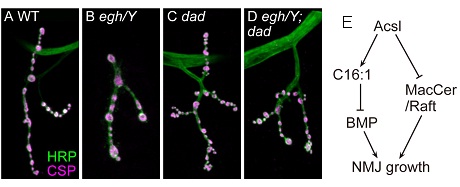Nervous system development and function are tightly regulated by metabolic processes, including the metabolism of lipids such as fatty acids. Mutations in acyl-CoA synthetase long-chain family member 4 (ACSL4) result in non-syndromic X-linked intellectual disability (ID). dAcsl, the Drosophila ortholog of ACSL3/4, inhibits synapse growth of neuromuscular junctions (NMJs) as dAcsl mutants exhibit overgrown NMJs. However, the molecular and cellular mechanisms by which dAcsl regulates NMJ growth are poorly understood.
The research group led by Dr. ZHANG Yongqing, in collaboration with Dr. SHUI Guanghou’s group, at the Institute of Genetics and Developmental Biology, Chinese Academy of Sciences, found that Acsl regulates the composition of fatty acids and membrane lipids, which in turn affects neuromuscular junction (NMJ) synapse development.
Acsl mutant brains showed a decreased abundance of C16:1 fatty acyls; restoration of Acsl expression abrogated NMJ overgrowth and an increase in BMP signaling. A lipidomic analysis revealed that Acsl suppressed the levels of three lipid raft components in the brain, including mannosyl glucosylceramide (MacCer), phosphoethanolamine ceramide and ergosterol. The MacCer level was elevated in Acsl mutant NMJs. MacCer, along with sterol, promoted NMJ overgrowth, but was not associated with the increase in BMP signaling in the mutants.
These findings suggest that Acsl inhibits NMJ growth by stimulating C16:1 fatty acyl production and concomitantly suppressing raft-associated lipid levels.
These results offer novel insight into the intricate regulation of lipid metabolism in the nervous system, and suggest a potential intervention strategy for dAcsl-associated disorders by manipulating BMP signaling via genetic and pharmacological means.
This work was supported by grants from the Ministry of Science and Technology, the Strategic Priority Research Program B of the Chinese Academy of Sciences, and the National Science Foundation of China.
MacCer and C16:1 fatty acid regulate NMJ growth in parallel genetic pathways. (Image by IGDB)
Contact:
Dr. ZHANG Yongqing
Email: yqzhang@genetics.ac.cn
 MacCer and C16:1 fatty acid regulate NMJ growth in parallel genetic pathways. (Image by IGDB)Contact:Dr. ZHANG YongqingEmail: yqzhang@genetics.ac.cn
MacCer and C16:1 fatty acid regulate NMJ growth in parallel genetic pathways. (Image by IGDB)Contact:Dr. ZHANG YongqingEmail: yqzhang@genetics.ac.cn CAS
CAS
 中文
中文




.png)
